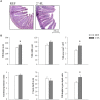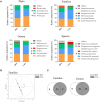Immunomodulatory and Prebiotic Effects of 2'-Fucosyllactose in Suckling Rats
- PMID: 31417553
- PMCID: PMC6685134
- DOI: 10.3389/fimmu.2019.01773
Immunomodulatory and Prebiotic Effects of 2'-Fucosyllactose in Suckling Rats
Abstract
Human milk oligosaccharides are unconjugated complex glycans present in high concentration in human milk that serve as pre-biotics and immunomodulators. They are not primarily absorbed or metabolized by the infant and reach the lower part of the intestinal tract unaltered. One of the main oligosaccharides found in human milk is 2'-fucosyllactose (2'-FL). This study aimed to investigate the effects of daily oral administration of 2'-FL in healthy suckling rats. From days 2 to 16 of life, rats were daily given the oligosaccharide (2'-FL) or vehicle (REF), weighed and their stool characteristics were assessed. On days 8 and 16 of life the morphometry, intestinal architecture, and cytokine release, mesenteric lymph nodes cell composition, plasma immunoglobulin concentrations, fecal microbiota composition, cecal short-chain fatty acids content, and the urinary metabolic profile were assessed. Animals given 2'-FL showed higher plasma IgG and IgA and more T cell subsets in the mesenteric lymph nodes on day 16. Moreover, at intestinal level, villus heights, and areas were increased on day 8. Cecal samples displayed a higher Lactobacillus proportion and a different urinary metabolic profile was observed on day 8, and a higher proportion of butyrate on day 16. In conclusion, supplementation of 2'-FL in early life has a pre-biotic and intestinal trophic effect and promotes maturation of the immune system.
Keywords: 2′-FL; HMO; immunoglobulins; metabolomics; microbiota.
Figures






References
Publication types
MeSH terms
Substances
LinkOut - more resources
Full Text Sources
Other Literature Sources
Miscellaneous

